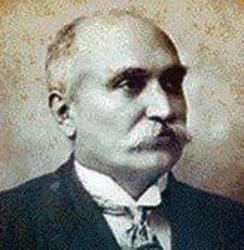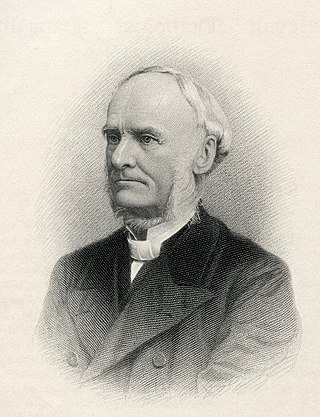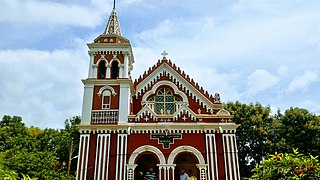Related Research Articles

Kannada, previously also known as Canarese, is a Dravidian language spoken predominantly by the people of Karnataka in southwestern India, with minorities in all neighbouring states. It has around 44 million native speakers, and is additionally a second or third language for around 15 million non-native speakers in Karnataka.
Epigraphia Carnatica is a set of books on epigraphy of the Old Mysore region of India, compiled by Benjamin Lewis Rice, the Director of the Mysore Archaeological Department. Over a period of about ten years between 1894 and 1905, Rice published the books in a set of twelve volumes. The books contain the study of about 9,000 inscriptions from lithic surfaces and copper plates, which were found in the region. Apart from the original inscription, an English translation and a Roman transliteration are also provided.

Benjamin Lewis Rice, popularly known as B. L. Rice, was a British historian, archaeologist and educationist. He is known for his pioneering work in deciphering inscriptions, especially in Kannada, and in Sanskrit inscriptions in the Kingdom of Mysore and is eulogized as shasanapitamaha or Purathathva Pitamaha Rice's researches were published as the voluminous Epigraphia Carnatica which contains translations of about 9000 inscriptions he found in the Old Mysore area. Rice also compiled the much acclaimed Mysore Gazetteer which still remains the primary source of information for most places in Mysore and neighbouring Coorg. Rice served with distinction in the Mysore civil service and as first Director of the Mysore State Archaeology Department.

Lakshmisa was a noted Kannada language writer who lived during the mid-16th or late 17th century. His most important writing, Jaimini Bharata is a version of the Hindu epic Mahabharata. The writing focuses on the events following the battle of Indraprastha between the Pandavas and Kauravas, using the Ashvamedha conducted by Yudhishthira as the topic of the epic narrative. The writing is in the shatpadi metre and was inspired by the Sanskrit original written by sage Jaimini.

Lieutenant-General Sir Mark Cubbon KCB was a British army officer with the East India Company who was the Chief Commissioner of Mysore 1834 to 1861. During his tenure, he established a law and order system, introduced judicial and economic reforms and through action in all spheres of governance helped develop the economy of Mysore. He resigned from his office in 1860 due to ill-health and left for England for the first time since his arrival in India as a cadet in 1800. The administration of the Kingdom of Mysore under his leadership ensured that the 1857 rebellion had almost no impact in the region. He died in 1861 on board ship at Suez. Cubbon Road and Cubbon Park in Bangalore are named after him.

Bengaluru Pete is the area of Bangalore city which was established by Kempegowda I in 1537 with roads laid out in the cardinal directions, and entrance gates at the end of each road. Kempegowda also termed the Pete he built as his "gandu bhoomi" or "Land of Heroes". Pete forms a well–defined body of markets which were associated with various trades and professions of the populace in the locality markets and given the names of trades pursued in such markets. The well known markets are the Tharagupete–market for grains, the Balepete – for Bangles and musical instruments, the Chikkapete and the Nagarthpete for textile trade, the Ballapurpete and the Ganigarapete market where oil is extracted by people of the Ganiga community, the Tigalarapete–flower market of gardeners, the Cubbonpete – textile manufacture by people of the Devanga community.

William Arthur was an Irish Wesleyan Methodist minister and author.

Étienne-Louis Charbonnaux was a French missionary and the first vicar apostolic of Mysore, India.
William Reeve (1794-1850) was a London Missionary Society missionary to India, author of an early dictionary of the Kannada language, and translator with John Hands of the Bible into Kannada. The dictionary was compiled from 1827 to 1834, when he was in Bangalore. His connection with the Society ceased 23 November 1835.

John Hands was a missionary of the London Missionary Society in India and, with William Reeve, translator of one of the first Bible translations into Kannada (1820). Hands founded the mission station in Bellary in 1810, after having failed to establish a base at Seringapatam.

Fred Goodwill (1874–1969) was a British missionary stationed in Bangalore, British India, between 1899 and 1924, serving as the superintendent of the Wesleyan Tamil Mission, Bangalore and Kolar Gold Fields. He is acknowledged for working for the cause of education of native women in the Bangalore Cantonment. The Goodwills Girls School located in Fraser Town, Bangalore Cantonment is named after him. He was a scholar of the Tamil Language, and was also fluent in Canarese (Kannada) and Telagu (Telugu). Fred is acknowledged as an authority on Tamil Shaiva Literature, with authors quoting from his research. As one of the founding members of the Mythic Society, his published papers on the history of the Mysore State form the basis of history of the State, as we know it now.
The Karnataka Central Diocese is one of the twenty-two dioceses of the Church of South India covering the central part of Karnataka.

The Kingdom of Coorg was an independent kingdom that existed in India from the 16th century until 1834. It was ruled by a branch of the Ikkeri Nayaka. From 1780 to 1788, the kingdom was occupied by neighbouring Mysore but the Rajah of Coorg was restored by the British and became a protectorate of the British East India Company on 26 October 1790. In 1834, the then Raja of Coorg rebelled against British authority, sparking the Coorg War. The brief conflict led to the British to annex the kingdom in the same year, who transformed the region into a province of British India.
The Rice Memorial Church is located in the busy Avenue Road, Bangalore Pete. It is named after Rev. Benjamin Holt Rice, a missionary of the London Missionary Society (LMS), a Canarese scholar and a pioneer of education in the Bangalore Pete region. The Rice Memorial Church stands on a busy street in the midst of temple, dargahs, book shops and heavy traffic, with its colonial British structure appearing to be out of place in the traditional Bangalore market district. The church stands on the site of the London Mission Canarese Chapel built by Rev. Rice, which itself was built on the site of the first Canarese chapel built by William Campbell in 1834. The church is a stone building in the European Classical style, with Tuscan columns, pediments and keystone arch windows. The church building has been demolished and raised at least 3 times, with the current structure consecrated in 1917.
The Hudson Memorial Church is located in the Bangalore Pete, Hudson Circle, surrounded by the Office of the Bangalore Corporation, Ulsoor Gate Police Station, Cubbon Park and Kanteerava Stadium. The church was established in 1904, and is a Kannada CSI church of the Bangalore Diocese. The church has around 4000 registered members and is named after Rev. Josiah Hudson, a missionary, Canarese scholar and educationist who started many Canarese schools in the Bangalore Petah region. The church was earlier known as the Wesleyan Mission Canarese Chapel, and was located in Ganikara Street, Nagarathpet, and moved the current location at Hudson Circle and renamed as Hudson Memorial Church in 1904. The church attracts people of all faiths, who visit the church to seek blessing, especially in Thursdays and Sundays.

Thomas Hodson was a Wesleyan Missionary, who served in India, in the Wesleyan Canarese Mission, at the Bangalore Petah and Gubbi. He helped in running the first Wesleyan Mission Canarese school in the erstwhile Mysore State. Hodson was a linguist and a Kannada scholar, and was also fluent in Tamil and Bengali. He helped in establishing the Wesleyan Canarese Chapel at Nagarthpete in the Bangalore Petah. In 1864, Hodson wrote An Elementary Grammar of the Kannada, or Canarese Language, a treatise on the grammar of the Kannada language.
The United Mission School is located on Mission Road, Bangalore and is managed by the Church of South India. The school offers English medium education and is affiliated to the Karnataka Secondary Education Examination Board. The school has classes from Year 1 to Year 10. In 1993, the United Mission Degree College was established on the same campus, offering Bachelor of Commerce and Bachelor of Business Management courses, affiliated to the Bangalore University.

The William Arthur Memorial Church is located on the Bangalore-Honavar Road at Gubbi Town, about 80 km from Bangalore. The church is painted brick red and built in the Gothic style, being completed in 1904. The church is named after William Arthur, an Irish Wesleyan missionary and Canarese scholar, who served in Gubbi. The present structure replacing the old Gobbee Chapel, built by Thomas Hodson. The church is managed by the Church of South India and comes under the Karnataka Central Diocese

Somawarpete taluk is one of the five taluks of Kodagu district. Its administrative headquarters is in the town of Somwarpet.
Daniel Sanderson was a Wesleyan missionary, who served in India, in the Wesleyan Canarese Mission, at the Bangalore Petah, Mysore, Tumkur and Gubbi, between 1842 and 1867. Sanderson was a linguist and a Kannada scholar. He is credited with co-authoring the first Kannada–English dictionary, published in 1858 by the Wesleyan Mission Press with the financial support by Sir Mark Cubbon. He also translated Lakshmisa's magnum opus, the Jaimini Bharata, into English. On return to England, he was appointed as the director of the Richmond Theological College.
References
- ↑ Madhusudana, K S (17 October 2019). "Reading a rare work: Rev. John Garrett's The BHAGAVAT-GEETA of 1846 in Kannada is a rare multi-lingual version". The Hindu. Retrieved 24 August 2022.
- 1 2 Findlay, D D; Holdsworth, WW (1924). The history of the Wesleyan Methodist missionary society, Volume V. London: The Epworth Press.
- ↑ "The king of all land parcels". Bangalore Mirror. 5 October 2017. Retrieved 25 August 2022.
- ↑ Kumar, Manasi Paresh (27 January 2011). "Lord of the manor". Bangalore Mirror. Retrieved 25 August 2022.
- ↑ "Gone With The Royalty". bengaluru.com. 15 April 2020. Retrieved 25 August 2022.
- 1 2 Shekar, Divya (6 March 2016). "The Balabrooie guest house in Bengaluru reminded the British of the Isle of Man". No. Bangalore. The Economic Times. Retrieved 25 August 2022.
- ↑ Katha Manjare, Or A Collection of Canarese Stories: With an English Translation and a Brief Canarese & English Vocabulary. Bangalore: Gopal Acharoo. 1841. Retrieved 24 August 2022.
- ↑ Rhodes, D E (1970). "Printing at Bangalore, 1840-1850". The British Museum Quarterly. 34 (3/4): 83–86. JSTOR 4423049 . Retrieved 24 August 2022.
- ↑ Cole, R A (1867). An Elementary Grammar of the Coorg Language. Bangalore: Wesleyan Mission Press. Retrieved 24 August 2022.
- ↑ Hodson, T (1864). An Elementary Grammar of Kannada or Canarese Language. Bangalore: Wesleyan Mission Press. ISBN 9785873933433 . Retrieved 24 November 2015.
- ↑ Reeve, William (1858). Sanderson, Daniel (ed.). A Dictionary, Canarese and english. Bangalore: Wesleyan Mission Press. Retrieved 18 January 2017.
- ↑ Garrett, John (1846). The Bhagavat-Geeta Or, Dialogues of Krishna and Arjoon, in Eighteen Lectures : Sanscrit, Canarese, and English, in Parallel Columns. Bangalore: Wesleyan Mission Press. Retrieved 24 August 2022.
- ↑ Garrett, John (1871). Classical Dictionary of India: Illustrative of the Mythology Philosophy Literature Antiquities Arts Manners Customs & C. The Hindus (PDF). Bangalore: Wesleyan Mission Press. Retrieved 24 August 2022.
- ↑ "The Wesleyan Mission Chapel re-built by the Revd. J. Garrett 1846 (Drawn by J Rozario [?] Junior Scholar High School)". Historic House Trust, NSW. Retrieved 20 November 2015.